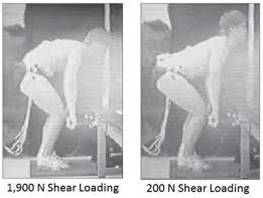One of the more popular cues trainers and coaches use when teaching the squat and deadlift is to arch the lower back….hard.
There’s a legitimate reason why, too. Squatting and deadlifting under load (consistently) into lumbar flexion is a major no-no, and usually results in any number of lower back dysfunctions and injuries. All someone has to do is open up either one of Dr. Stuart McGill’s seminal books on the topic – Low Back Disorders or Ultimate Back Fitness and Performance – to be slapped in the face 10x over with research study after research study proving this point.
Cueing someone to avoid (loaded) flexion and to arch their back while squatting and deadlifting engages the muscles of the back – erectors, iliocostalis, longissimus, multifidi – which not only helps to both stabilize and strengthen the spine, but also aids in offsetting and drastically reducing shear force.

It’s a hard to debate this point and has long been accepted as the “correct” way to cue proper form and technique.
However, the fitness industry runs on a perpetual pendulum of extremes – the middle ground is for pansies – and if doing “x” amount of something is good then doing even M.O.R.E of “x” must be really good. Weeeeeeeeeeeeeeeeeeeeeeeeeeeeeeeeee.
Arching the back is fine. Excessively arching the back, long-term, not so much. Just like we would shit an EMG study over excessive spinal flexion, excessive spinal extension is just as deleterious and detrimental to the spine.
In extreme cases:
Repetitive, excessive spinal flexion = disc herniations
Repetitive, excessive spinal extension = end plate, pars fractures.
It’s no coincidence we’ve seen the rise of things like Spondylosis, Spondylolisthesis, and other extension-based dysfunctions in the fitness and athletic realms – in both young and old(er) populations.
In younger populations a large portion of the blame can be pointed to more and more kids being less active, ill-prepared, and/or specializing in one sport too soon (pattern overload).
In older populations the blame can be directed towards some of the same culprits, albeit I’d also argue a major monkey-wrench is how we as coaches and trainers have been cueing our athletes and clients for the better part of a decade (if not longer) into OVER-arching during their squats and deadlifts.
It’s great for lifting a metric shit-load (a shade more than a metric boat-load) of weight, but not so great for long-term back health.
In the video below I break down why cueing more posterior pelvic tilt (in addition to owning your rib position) during squats and deadlifts may be more advantageous in the long run. Remember: All we’re trying to do is encourage people back to “neutral,” from an excessive extension pattern, and to own that position during their lift(s). So, instead of thinking of it as “arch and sit back,” it should be “find neutral, set/own ribs,bace, and sit down.” I think this not only has merit with regards to back health, but performance as well. Give it a looksy.
Side Note: Eric Cressey discusses the same concept (in more detail) in Functional Stability Training for the Lower Body if you want to dive more into the topic.


